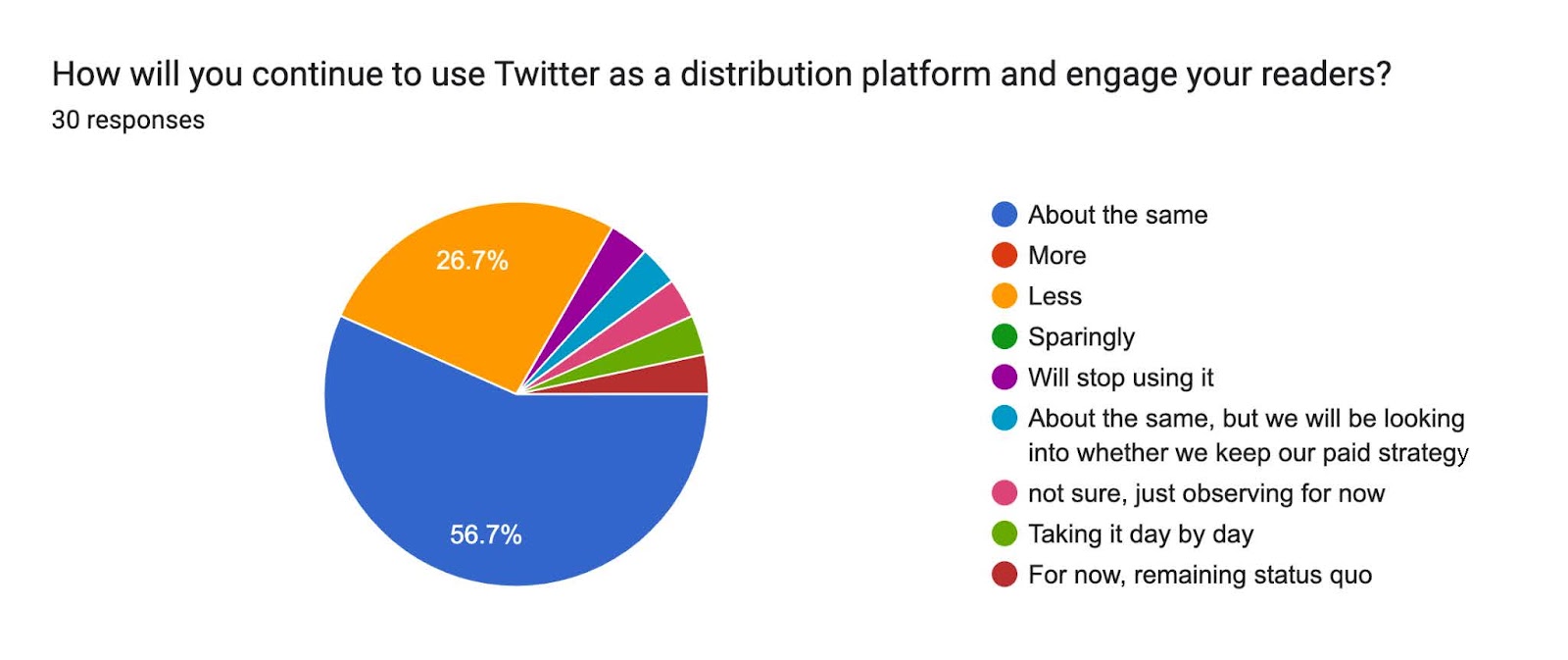Beyond Twitter and Meta: What’s next for social media
Published February 14, 2023
When Elon Musk completed his acquisition of Twitter at the end of October 2022, it signaled the end of the golden age of social media for news organizations. Meta had already started winding down its news partnership efforts, and the rapid gutting of Twitter’s workforce and volatile changes meant news outlets could no longer rely on the platforms for distribution, funding, audience growth or community engagement.
In December, the American Press Institute and the Online News Association hosted a virtual conversation to discuss how these ongoing challenges impact publishers. API Newsroom Success Manager Shay Totten shared preliminary findings from an ongoing survey API is conducting to assess how newsrooms were initially responding to the changes at Meta and Twitter. More than half of the 30 respondents (57%) said they planned to stay active on Twitter with roughly the same level of engagement, while more than 25% said they would post less. About 10% of respondents said they were taking it day by day, and 3% of respondents said they stopped posting on Twitter. 
Respondents also shared which platforms they were planning on moving to in lieu of Twitter. Instagram led the way at 30%, and LinkedIn, TikTok or Facebook tied for second choice at 13% each.

“We have to be in these spaces where readers are to combat misinformation and build relationships with younger readers on those platforms,” Totten said.
Presenters also shared case studies on innovative ways newsrooms connect with their audiences outside of traditional social media platforms.
- Moving on from the way it’s always been done — The Chattanooga Times Free Press reached younger audiences by rethinking its approach to a major annual city event.
- Using LinkedIn to reach and engage younger audiences — Automotive News used LinkedIn’s live feature to reach a new professional readership.
- How metrics and surveys can help you better understand and serve your community — The Arizona Daily Star used surveys to better understand its Spanish-reading audience and Tucson’s wider Hispanic community.
- The homepage is not dead in Seattle and yours shouldn’t be either — How the Seattle Times brought its homepage back to life by updating it more frequently and paying close attention to what readers are interested in.
Below is a recap of other trends and challenges attendees and facilitators discussed. Please note that breakout sessions were not recorded, so this text-based recap serves as a summary of the event. You can watch the event introduction section video embedded in this recap.
ONA hosts conversations throughout the year at the intersection of journalism and technology, including at its annual conference. Visit ONA’s events page to find out what’s next.
Platform alternatives
As shown in Totten’s survey, newsrooms are exploring a variety of platform alternatives to Twitter. API’s Totten and Hanaa Rifaey, Partnerships Consultant at ONA, facilitated a discussion on where news organizations are experimenting.

Credit: Brad Gerick
- LinkedIn is becoming more friendly to content creators, and newsrooms have seen an uptick in engagement on LinkedIn, thanks in part to the new Repost feature. People-focused content performs well on the platform, and newsrooms can tag people in posts without being connected with them. Personal touches excel, so users need to do more than post links — provide a TL;DR, ask questions or share facts from the story. Although there is less trolling on LinkedIn, comments are still low.
- Instagram is often used by newsrooms as a storytelling platform to build trust, since converting users to subscribers or driving site traffic is difficult. Some newsrooms have been able to build up mini-communities among the regular commenters on their posts who may not be traditional subscribers.
- Newsletters have become a priority for many newsrooms, and that’s paying off in the wake of social media disruption. Many news organizations plan to continue building and innovating with their newsletter platforms.
SMS messaging also offers some success. Using platforms such as Subtext allows reporters to build out “texting clubs” around their beat, as well as general newsroom clubs. - NextDoor might show some promise in the future — the neighborhood platform’s CPO is formerly LinkedIn’s VP of product, so many of the innovations rolled out on LinkedIn come to NextDoor. One newsroom reported partnering with NextDoor required a big lift and not a lot of return.
- Discord and Mastodon are still experiments for most newsrooms. Though some participants noted that concerns about barriers to entry to these server-based platforms may be overblown, it can be difficult to find the right servers or audiences for general news organizations.
Other ways to connect communities
Social media will continue to become more fractured, but Twitter’s role in connecting communities will be hard to recreate, said Susan Gonzalez, Chalkbeat’s Social Media Strategist. While news organizations have gotten better about audience engagement teams, they’ll have to be a lot more robust in the future, she added.
Gonzalez facilitated a discussion where participants shared their concerns about connecting with younger audiences for news tips, something that has long been a hurdle but could be made even more difficult without Twitter or Facebook. And as social media continues to fracture, newsrooms may need to navigate several platforms over time to stay connected to various audiences.
Approaching social media as a way to connect with audiences, not just as a promotional tool, can help guide newsrooms to alternatives. Offline approaches such as community listening sessions, physical cards and mailers, and partnerships with libraries might be a good place to start. Messaging platforms such as WhatsApp and Slack can be used for targeted messaging and community building, as well.
- As your community grows, pay attention to the onboarding experience, especially those trying out new platforms — Slack is disorienting. Make sure to use bots to welcome and onboard.
- Use bots intentionally on these platforms.
- Have strong security measures — make sure users can’t compromise security and privacy or add their own bots.
Adapting to distribution changes
It can be difficult to contextualize what is happening with Twitter and Meta and how to respond, especially in smaller newsrooms that don’t have the resources to build up other platforms.
The slowdown in distribution may help journalists figure out how to better serve their communities — at the height of these platforms’ popularity, newsrooms were falling prey to bad habits such as chasing algorithms for clicks or publishing stories irrelevant to their communities, noted facilitator Apryl Pilolli, Technology Director of the Knight x LMA BloomLab at the Local Media Association. Newsrooms now have the opportunity to rebuild those relationships with their audiences.
An engagement-forward distribution strategy can be hard to shape when social media platforms are so volatile. Taking an audience-first approach and determining your target audience, what they want and where they congregate can help answer what you do to meet your audiences.
Meanwhile, newsrooms can take advantage of tools to streamline their workflows as they adjust their distribution approaches.
- Canva
- Especially for smaller newsrooms without extensive visual resources to create their own templates or use pre-made templates at a reasonable cost
- Photoshop
- Not new, but creating templates has been helpful for quickly pushing content
- TopicPulse
- Audience trends and powerful video components
- True Anthem
- Help post across multiple social platforms at once and analyze analytics
- YouTube
- Use their SEO feature
Alternative platforms for freelancers
Twitter and Facebook have long been used to connect editors and freelancers — editors put out calls for pitches, and freelancers share their work or projects they’re looking to publish. This is especially true for communities of color and disability advocates. However, the platform’s tanking engagement is hurting freelancers’ business. Journalist and freelance audience consultant Adriana Lacy facilitated a discussion with freelancers on how they’ve been expanding their engagement.
Participants found success in intimate groups functions like Facebook’s groups, which are organized around themes such as science journalism. Subtext’s new chat feature shows some promise, and others are figuring out the ins and outs of starting on TikTok.
- Mastodon offers better engagement and more opportunities for conversation — it can be good for finding sources and asking questions. However, current users don’t want to see Mastodon become like Twitter. When using this platform, be respectful of longtime Mastodon users.
- Facebook groups can be helpful for connecting and promoting business, as well as conducting surveys and getting feedback. Consider starting a Facebook group for your subscribers, clients or followers — but keep in mind that you would also have to serve as the group’s moderator.
- TikTok can be a great funnel to convert people with similar interests, and it now has a media category. Consider creating an explainer video about an article you wrote. People who come across your content might have questions, and it could be a good opportunity to create more videos with responses — explainer videos are successful on TikTok.
- LinkedIn can be a good option if your focus is business and entrepreneurship. The LinkedIn for Journalists program offers users Premium access for free, and the platform is becoming friendlier to creators.
Business impacts and loss of funding
Some newsrooms have seen the writing on the wall, especially with Meta pulling news, content and event support over the past couple of years, said Upasna Gautam, Product Manager for Digital News Platforms at CNN.
Regardless, many newsrooms have relied on large tech organizations willing to fund journalism and media directly because traditional funders of journalism have been overwhelmed with requests in recent years.
“We need to remind ourselves that we can’t stop thinking agilely,” she said. “Whatever we depend on today may not be around tomorrow.”
Moving forward, news organizations need to diversify where they get their funding — and that might mean thinking outside the box.
- How do media organizations fit in nontraditional funding spaces? For funders focused on niche topics like democracy or housing inequality, pitch how your coverage can support those missions. Solutions-oriented editorial projects could be a good fit for this kind of funding.
- Proactively reach out to smaller, local funders who might have donor-advised funds to give.
- Collaborate with other news organizations to use a similar approach in soliciting funders.
- Play the long game by diversifying funding with nontraditional sources such as philanthropic individuals who might bequeath funding.
Speakers
Moderators






